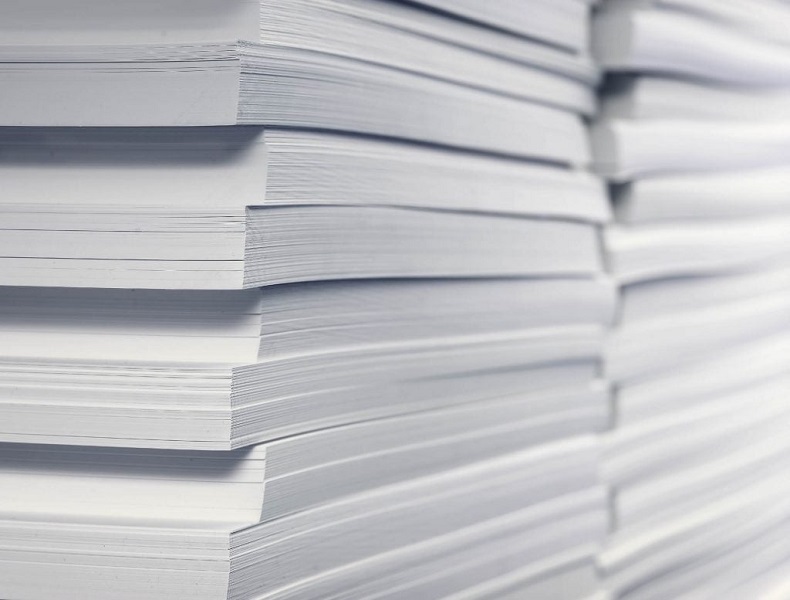7 types of calcium carbonate commonly used in the paper industry

The paper industry is one of the largest markets for calcium carbonate. As an important paper-making filler and coating pigment, calcium carbonate is rich in sources and cheap in price; fine particles and high whiteness can significantly improve the opacity of paper; fast ink absorption speed can increase Ink absorption of paper; it can make the paper softer, tighter and more glossy; it has little effect on the physical strength of the paper.
At present, the types of calcium carbonate commonly used in the paper industry mainly include heavy calcium carbonate, light calcium carbonate, nano calcium carbonate, mixed calcium carbonate, modified calcium carbonate, calcium carbonate whiskers, and slurry calcium carbonate.
1. Heavy calcium carbonate
Ground calcium carbonate is used as a paper filler, and the addition amount is relatively high, which has little effect on paper strength and sizing effect, and has good paper making performance. The disadvantage is that the whiteness and opacity of the paper are slightly poor, and a dispersant needs to be added.
Ground calcium carbonate is mainly used as a filler in printing paper, writing paper, office paper and advertising paper other than cigarette paper, filter paper and special low-quantity information paper.
2. Light calcium carbonate
As a paper filler, light calcium carbonate can make the paper have high opacity, low wear on the paper machine, and no need to add dispersant. The disadvantage is that the specific surface area is large, which will damage the sizing effect; the water retention is strong, which is not conducive to the increase of the speed of the paper machine.
3. Nano calcium carbonate
After adding nano-calcium carbonate fillers in the papermaking process, the paper has the following characteristics: it can slow down the aging of the paper, so that the paper can be stored for a longer time; it can make the paper absorb a certain amount of ultraviolet rays; it makes the paper not easy to yellow or fade Brittle, and has good isolation properties, etc.
As a paper-making filler, nano-calcium carbonate is generally used in the production of special paper products, such as diapers, sanitary napkins, color-jet printing paper, paper towels and breathable films.
4. Mixed calcium carbonate
Mixed calcium carbonate (HCC) is to use ionic polymer to prepare the mixture of ground calcium carbonate and calcium oxide into pre-agglomerates, and then treat the pre-agglomerates with carbon dioxide to form new calcium carbonate between GCC and finally form carbonic acid calcium products. The post-mixed calcium carbonate preparation process is roughly the same as the HCC preparation process, except that the first aggregate is formed only from ground calcium carbonate, and after the ground calcium carbonate pre-agglomerate is prepared, the same amount of calcium oxide as the HCC process is added, and then carbon dioxide is injected. New calcium carbonate is formed on the outside of the first aggregate of GCC, and the final calcium carbonate product is post-mixed calcium carbonate (PostHCC or pHCC).
5. Modified calcium carbonate
Surface modification of calcium carbonate can endow calcium carbonate with excellent physical and chemical properties. For example, chitosan was used to modify the organic coating of precipitated calcium carbonate (PCC) by alkali precipitation method. After modification, the water filtration performance of the filled slurry was slightly improved, and the solubility also changed. The tensile index of the paper is significantly improved.
6. Calcium carbonate whiskers
Calcium carbonate whiskers belong to the aragonite calcium carbonate crystal structure, have high elastic modulus, heat resistance, wear resistance and heat insulation and other good properties, and have the whisker material with large aspect ratio, short fiber and small diameter ( Micron level) and high strength characteristics.
7. Slurry calcium carbonate
Practice has proved that the use of slurry calcium carbonate has more powerful advantages than solid calcium. On the one hand, the slurry calcium has not gone through the drying process, that is, without mechanical friction and collision, and fully retains the naturally formed crystal form, and the shape and size tend to be more consistent. On the other hand, the calcium slurry has not undergone mechanical friction and collision, and the crystal debris is less, and the end of the crystal form retains the original blunt state, and there is almost no damage.
Heavy calcium carbonate, light calcium carbonate, nano-calcium carbonate, mixed calcium carbonate, active calcium carbonate, calcium carbonate whiskers, etc. have their own advantages as paper-making fillers. Therefore, the choice of calcium carbonate should be determined according to the actual paper production process requirements. Certainly.
